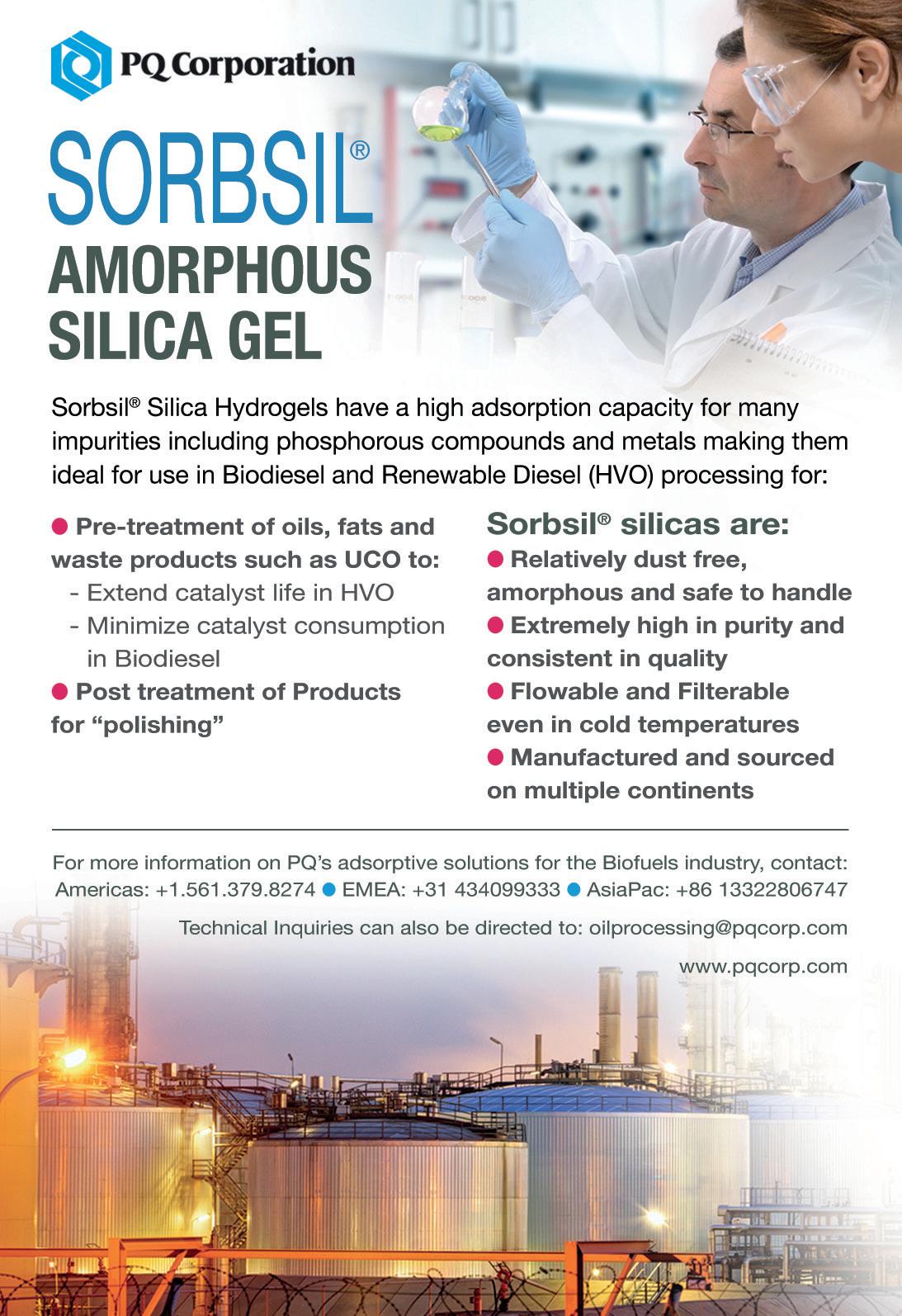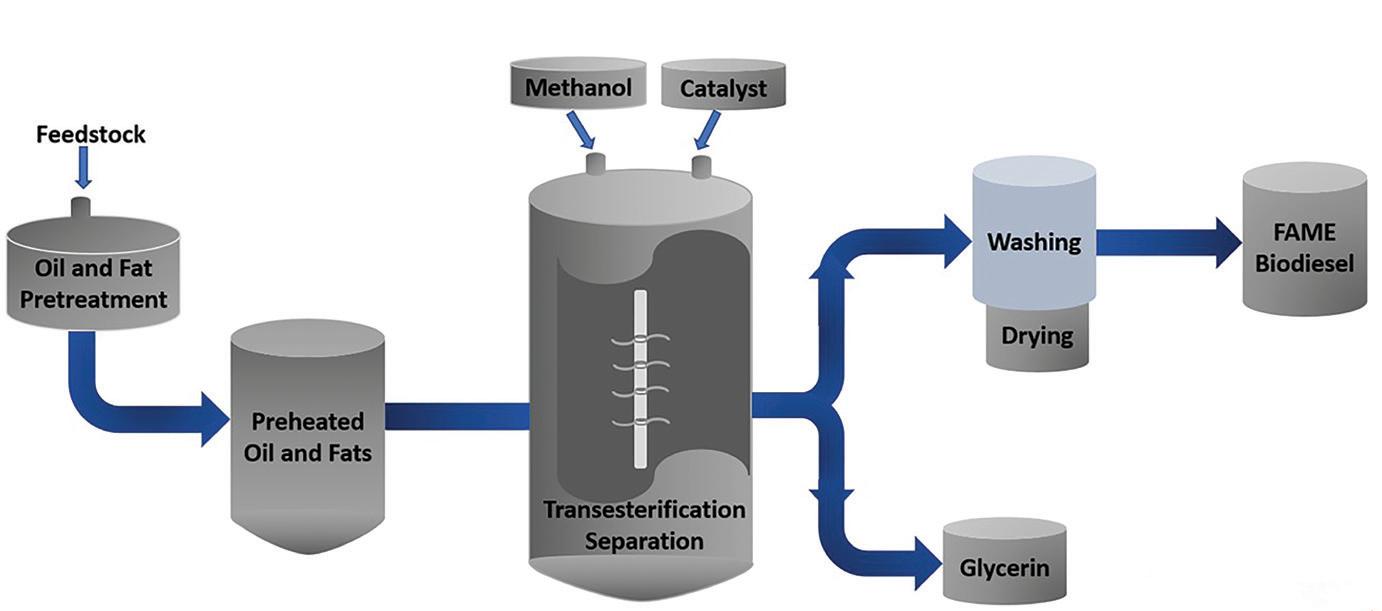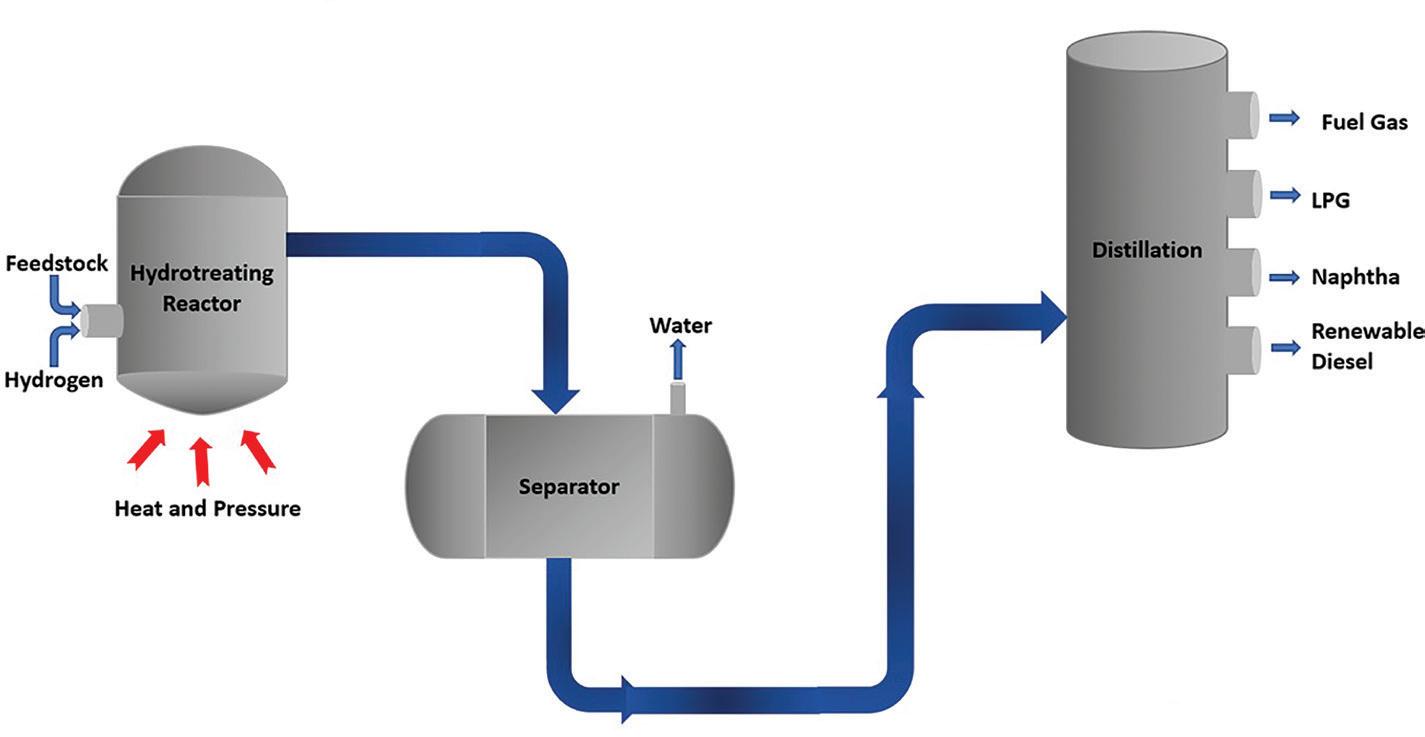4 minute read
Biodiesel versus renewable diesel
Next Article
petroleum diesel would remain liquid. This makes transporting it with the same infrastructure impossible.
Renewable diesel can start as inedible oils, such as woody biomass and corn oil, or the same feedstocks as biodiesel.
There are several methods to produce renewable diesel including hydrocracking of vegetable oil to produce hydro-treated vegetable oil (HVO), catalytic conversion of sugars, or gasification to produce syngas. However, the only current commercial method is the HVO process, which pumps hydrogen gas into a hightemperature, high-pressure reactor with a filtered feedstock and catalyst, followed by distillation (see Figure 2, following page).
The process requires only a feedstock and hydrogen as inputs. It generates several additional end products, including biopropane (LPG) and naptha, a highly flammable hydrocarbon and industrial solvent.
Processors use different starting materials but similar methods to produce renewable diesel and petroleum-based diesel, resulting in similar products to the point that they have the same American Society for Testing and Materials number (ASTM D975).
Renewable diesel is different from biodiesel in several key ways beyond just how it is made.
It can be directly used in a diesel engine without any need for blending. Although there are seven approved methods to produce renewable diesel, it is currently only commercially produced using the HAME (hydroxyalkanoate methyl esters) route. This process utilises bacteria that produces polyhydroxyalkanoates (PHAs) and generates a fuel that is low in nitrogen and sulphur, resulting in less pollutants emitted when burned compared to petroleum diesel.
Another key difference is that u renewable diesel is sold as an 80% renewable/20% biodiesel blend in the USA for optimal lubricity performance while biodiesel can be bought at 100%.







Benefits over traditional diesel
Both renewable diesel and biodiesel address demands for lower carbon emissions from government agencies and from consumers.
Source: FarmDoc Daily
According to Sheehan et al (1998), the carbon intensity (CI) score of soyabean oil would allow for a 78% reduction in greenhouse gases if petroleum-based diesel is replaced with biodiesel made from 100% soyabean oil.
An update to this in 2012 by Pradhan et al estimated that 100% soyabean oilbased biodiesel could reduce greenhouse gas emissions by anywhere from 76% to 85%, depending on whether the model accounts for agricultural lime applications and nitrous oxide emissions.

Source: Farmdoc Daily
As of October 2022, the updated Greenhouse Gases, Regulated Emissions, and Energy Use in Transportation (GREET) model developed by Argonne National Laboratory, USA, estimated that the reduction is slightly lower for the average gallon of biodiesel and renewable diesel –around 72%. To calculate this, they used the feedstock mix provided by the US Energy Information Administration (EIA).
Increasing the crush capacity of soyabeans to produce feedstock oil for biodiesel will also result in increased soyabean meal available at economical prices for livestock producers. This could lead to increased meat availability, which would provide more food for people as a result of biodiesel production, not less.

Biodiesel adoption also improves air quality and can have significant positive effects on human health in high-risk areas, such as major metropolitan regions.
Source: Clean Fuels Alliance America, Trinity Consultants
Using standard air dispersion modelling from the EPA, a 2022 study by Clean Fuels Alliance America (CFAA) and Trinity Consultants found that switching to 100% biodiesel from petroleum diesel in 15 cities avoided over US$7bn in health costs and prevented 910 premature deaths per year (see Figure 3, left).

Additionally, on a yearly basis, the switch to biodiesel could reduce the number of sick days taken by more than 141,000 people and prevent or reduce the severity of 456,000 asthma cases.
Looking long term, they estimated that the improvement in air quality would lead to 9,500 fewer cancer cases over 70 years.
Biofuels can further contribute to reducing carbon emissions by using agricultural waste, such as biomass from specific cover crops like pennycress, to create renewable diesel.
Biodiesel also possesses the ability to clean and lubricate engines, a rare example of a product that is both more sustainable and better for the machine.
Biodiesel vs renewable diesel
Certain countries may focus on biodiesel over renewable diesel, or vice versa, based on the availability of feedstocks.
Biodiesel is typically made from vegetable oils, animal fats or waste cooking oil, which are readily available in certain regions. For example, countries with a large agricultural sector or high consumption of cooking oils may have an abundance of these feedstocks, making biodiesel a logical choice.
In contrast, renewable diesel can also be made from non-food feedstocks, such as waste oils or forestry residue. The availability of these feedstocks may be more limited in some regions.
Government policies and incentives provide another driving force in production choices. Some countries may provide greater financial incentives or regulatory support for the production and use of biodiesel, while others may favour renewable diesel.
In the USA, for example, the Renewable Fuel Standard (RFS) programme requires a certain volume of renewable fuels, including both biodiesel and renewable diesel, to be blended into transportation fuels. However, the RFS programme provides different incentives for biodiesel and renewable diesel, which could impact production volumes. Specifically, according to the US Department of Energy, biodiesel needs to reduce greenhouse gas emissions by 50% over its life cycle, while renewable diesel is required to reduce them by 60% to meet RFS thresholds.
Additionally, the production process and technology used for each fuel differs. The choice of technology may depend on factors such as the availability of infrastructure and the cost of production.
Quality assurance
When considering the quality of biodiesel, two abbreviations often come up –ASTM (American Society for Testing and Materials) and BQ9000.
ASTM standards are internationally recognised metrics used to establish the quality of various fuels and materials, including biodiesel. First released in 2001, the ASTM D6751 specification outlines the requirements for biodiesel that is intended for use in diesel engines. This specification includes parameters for properties such as purity, flash point, viscosity, cloud point, acidity and others.
BQ9000 is a voluntary quality assurance programme for the biodiesel industry. The CFAA, previously known as the National Biodiesel Board, developed it in conjunction with the National Institute of Standards and Technology. BQ9000 incorporates a set of ASTM standards, but also includes additional requirements such as storage, handling and sampling practices. BQ9000 also entails an on-site audit of a biodiesel producer's quality management system.
In summary, ASTM D6751 defines the quality parameters for biodiesel, while BQ9000 is a comprehensive quality management programme that includes ASTM D6751, as well as additional specifications for quality control.
This means that BQ9000 is not a type of diesel or even a promise of quality, but rather a guarantee that a facility has sufficient quality control in place to prevent any of its diesel from not meeting ASTM standards. ● Erica Curles is a science communicator and Keith Cockerline is director of industrial uses at association management company Smithbucklin, USA











